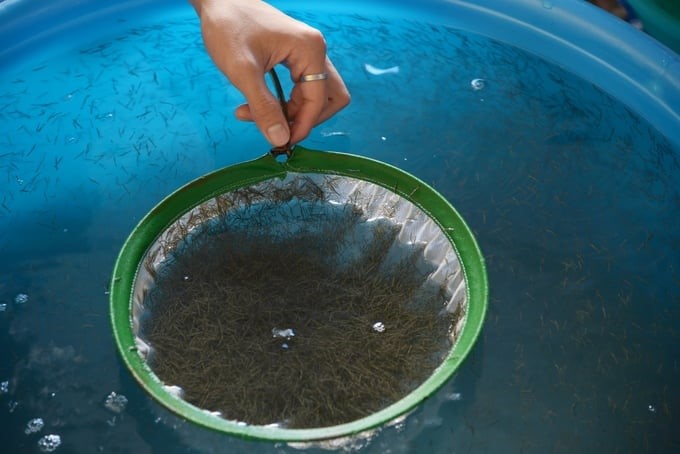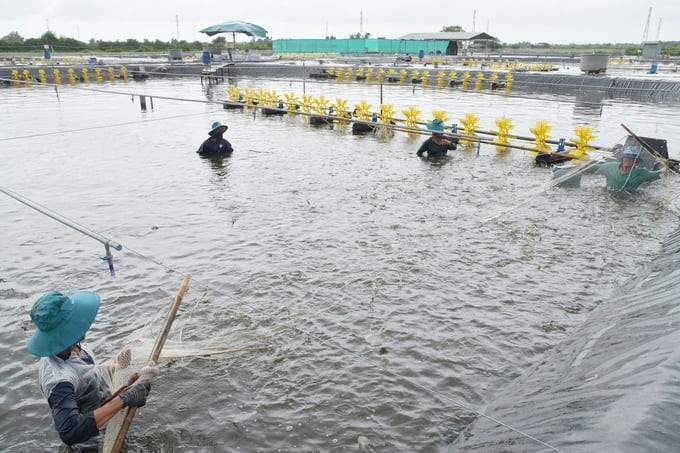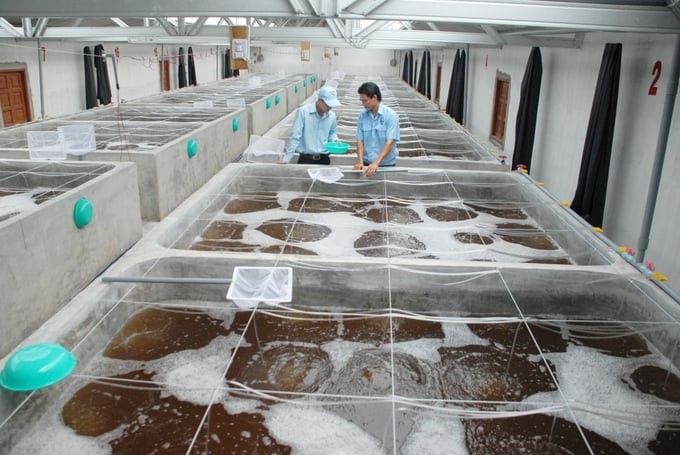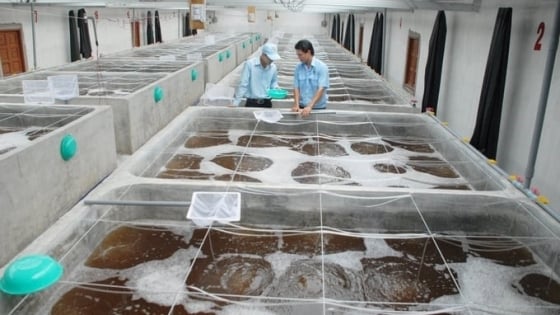(VAN) ‘This is a paradox that creates conditions for small shrimp seed production facilities to exist and creates unfair competition with standard production facilities.’
Poor-quality shrimp seeds affect productivity
According to a report from the Directorate of Fisheries (Ministry of Agriculture and Rural Development), the whole country currently has 2,270 brackish water shrimp seed production and nursery facilities, including 1,071 giant tiger prawn seed facilities, 443 whiteleg shrimp seed facilities , and 756 mixed production facilities.
Brackish water shrimp seed production reached more than 153 billion heads. Of which, giant tiger prawn seeds reached 43.6 billion heads, and whiteleg shrimp seeds reached nearly 110 billion heads.
Vietnam’s key shrimp seed production provinces are Ninh Thuan, Binh Thuan, Bac Lieu, and Ca Mau, accounting for about 93% of the total production facilities and 63.6% of seed output. Key nursery provinces include Ninh Thuan, Binh Thuan, Ben Tre, Bac Lieu, Ca Mau, and Kien Giang, accounting for 89.5% of total production facilities and 77% of the country’s total output.

The whole country currently has 2,270 brackish water shrimp seed production and nursery facilities. Photo: Hong Tham.
Seed prices fluctuate widely between localities and production facilities. The price of giant tiger prawn seeds from corporations or large seed production facilities is VND 100–168 VND/head; the price of whiteleg shrimp seeds is VND 100–135/head. The above-mentioned selling prices do not include promotional shrimp seed. Most facilities offer promotions of 30–50%, depending on the time; near the end of the year, there are facilities with promotions of up to 70–100%.
Mr. Duong Thanh Thoai, General Director of Duong Hung Mien Trung Seafood JSC (Quang Nam), said that although there is now supervision and control of the management unit in seed production, the conditions of many shrimp seed production facilities are still not guaranteed.
The shrimp seed production industry in Vietnam currently has over 2,000 production facilities, but according to observations, the number of small production farms accounts for the majority, and the number of standard shrimp seed production facilities is still limited.
“On the other hand, shrimp farmers have the mentality of preferring quality shrimp seeds, but at cheap prices and with many promotions. This is a paradox that creates conditions for small shrimp seed production facilities (market shrimp) to exist and creates unfair competition with standard shrimp seed production facilities,” Mr. Thoai emphasized.
According to Mr. Thoai, small shrimp seed production facilities have low investment, do not ensure standards, and are willing to sell at low prices and offer many promotions. However, when farmers buy poor-quality seeds, it will affect productivity, and the risk of disease spread and outbreak is very high.
Only accounting for 8–10% of the total production cost, but success or failure still depends on seed
Mr. Tran Cong Khoi, Head of the Aquaculture Seed and Feed Department (Directorate of Fisheries), shared that in the cost structure of producing whiteleg shrimp and giant tiger prawn, the seed cost only accounts for about 8–10%, but this factor plays a very important and decisive role in the success rate of shrimp farming. The low survival rate of shrimp also contributes to increasing the cost of production.
“The survival rate of Vietnamese shrimp in commercial farming is now still low due to unguaranteed farming conditions, diseases, unstable seed quality, and small, household farming scale with little investment in infrastructure,” said Mr. Khoi.
Besides, according to Mr. Khoi, the source of parent shrimp provided for shrimp seed production currently mainly depends on imports. Only a small portion of parent shrimp comes from natural exploitation and domestication, causing parent shrimp production to be dependent. This may also be one of the factors contributing to increasing the cost of production.

The survival rate of Vietnamese shrimp in commercial farming is now still low due to many factors, such as diseases, unstable seed quality, small farming scale, etc. Photo: Hong Tham.
According to a report from the Directorate of Fisheries (Ministry of Agriculture and Rural Development), in 2023, the whole country imported about 152,500 parent whiteleg shrimp (equal to 89% compared to 2022) and 1,079 parent giant tiger prawns (equal to 329% compared to 2022). Imported giant tiger prawn larvae were 39,600 heads, and imported whiteleg shrimp larvae were 16,991,600 heads. Parent shrimp are imported mainly from the US and Thailand.
The report also shows that the proactive source of parent shrimp from domestic research and breeding is still very limited. Parent shrimp depend on imports (87% for whiteleg shrimp) and wild exploitation (40% for giant tiger prawn). Domestic parent seeds can only provide a part, causing shrimp seed production to be dependent.
Sharing the same opinion, Mr. Thoai also said: “Currently, for shrimp farmers, the seed cost only accounts for 8–10% of the total production cost. However, this is the decisive factor in shrimp farming efficiency.”
As a shrimp seed producer, Mr. Thoai advised that in order to reduce the cost of production in shrimp farming, farmers need to choose reputable, branded shrimp seed production facilities with methodical and meticulous investment in facilities, synchronous production processes combined with advanced technology, and trained production human resources.
Select seed production units with product evaluation systems and standards, a commitment to quality, disease safety assurance, and rapid growth due to genetic factors.
Choose shrimp seed suppliers with a technical consulting team that is responsible for customers to always accompany and promptly support in case of need.
“Successfully doing these things will limit many risks in the shrimp farming process, especially regarding seed issues, thereby creating a premise for the success of the farming crop, reducing seed costs, and reducing the cost of production in shrimp farming,” Mr. Thoai emphasized.
Solutions to improve the quality of seed
In response to the proposal that “it is necessary to strictly control the quality of shrimp seed” of many shrimp seed production businesses today, including Duong Hung Mien Trung Seafood JSC (Quang Nam), Mr. Khoi said that, in the coming time, the Directorate of Fisheries will coordinate with localities and other functional agencies to improve the quality of seed.

Farmers should choose seed production units with product evaluation systems and standards, commitment to quality, disease safety assurance, and fast growth due to genetic factors. Photo: Hong Tham.
Strengthen inspection and testing of production conditions and the quality of seed at production facilities and when circulating on the market. Enhance coordination in brackish water shrimp seed management between seed-producing provinces and seed-consuming provinces.
Recommend small-scale production facilities to invest in building water and wastewater treatment systems, quality control, and biosafety in seed production. Encourage seed production facilities to apply advanced science and technology to improve quality and survival rates.
Digitize data on aquatic seeds so that people and management agencies can look up and retrieve information about origin and quality, contributing to preventing seeds from being produced at unqualified facilities.
Continue to research parent shrimp domestication for them to have good resistance to diseases and the environment and high productivity.
Mr. Duong Thanh Thoai, General Director of Duong Hung Mien Trung Seafood JSC (Quang Nam), said: “Small shrimp seed production facilities have low investment, do not ensure standards, and are willing to sell at low prices and offer many promotions. However, when farmers buy poor-quality seeds, it will affect productivity, and the risk of disease spread and outbreak is very high.”
Agriculture News | Agri Products Price



